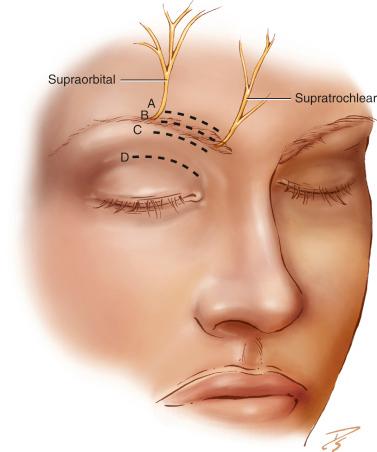Physical Address
304 North Cardinal St.
Dorchester Center, MA 02124
Modern trephination of the frontal sinus was first described in 1884 by Ogston.
Since the 1980s, endoscopic sinus surgery has been considered the standard of care for the initial surgical management of frontal sinus disease, except in select cases.
Despite endoscopic advancements in the field, frontal trephination is an essential part of a sinus surgeon’s armamentarium.
Trephination provides the surgeon with an additional port for dissection, a means of rapid decompression of the frontal sinus via an intersinus septectomy, or resection of tumors that cannot be completely addressed through an endoscopic approach.
There are a number of indications for frontal trephination alone or in conjunction with an endoscopic procedure.
The frontal sinus is a pyramidal structure that resides in the anterior cranial vault and is enveloped by two layers of cortical bone: a thick anterior table and a thinner posterior table.
The anterior wall of the frontal sinus begins at the nasofrontal suture line and ends below the frontal bone protuberance.
The anterior wall ranges from 4 to 12 mm in thickness. From superficial to deep, it is covered by layers of skin, subcutaneous fat, the frontalis muscle, and the pericranium.
The frontal sinus has two extensions:
Superior into the squamous portion of the frontal bone
Posterior into the orbital part of the frontal bone between the inferior surface of the frontal lobe and the orbital contents
The intersinus septum is a triangular bony structure that separates the frontal sinus into two independently draining cavities. It can vary in its position so that the frontal sinus cavities may be asymmetric.
The frontal sinus is lined by a mucosa of pseudostratified ciliated columnar epithelium.
The frontal recess is part of the frontal sinus outflow tract.
The outflow tract has an hourglass shape. The frontal recess is defined as the narrowest part of the tract and is the most inferior aspect of the frontal sinus.
The frontal recess is bounded by the following structures:
Superior lamina papyracea laterally
Vertical lamella of the middle turbinate medially
Nasofrontal bone anterosuperiorly
Agger nasi cell anteroinferiorly
Skull base posteriorly
The supraorbital and supratrochlear nerves innervate the soft tissue anterior to the frontal sinus and nearby areas.
Supraorbital nerve ( Fig. 32.1 )
Branch of the ophthalmic nerve (V1)
Passes through the supraorbital foramen (located just above the upper rim of the orbit at the junction of its medial and lateral two-thirds), courses deep to the corrugator muscle, then penetrates superiorly through the frontalis muscle
Travels in the dense subcutaneous tissue of the scalp
Supplies sensation to the skin of the forehead and upper eyelid
Gives a branch to the frontal sinus via the opening for the frontal diploic veins

Supratrochlear nerve (see Fig. 32.1 )
Passes superior to the trochlea of the superior oblique muscle and exits medially to the supraorbital foramen and passes around the superior orbital rim, deep to the frontalis muscle
Penetrates the orbital septum with the supratrochlear artery
Penetrates through the body of the corrugator muscle
Innervates the skin and conjunctiva of the upper eyelid and the skin of the lower medial forehead
Frontal sinus trephination is ideal in cases in which a purely endoscopic approach is not feasible and an open osteoplastic flap procedure is too aggressive.
If there is any doubt as to whether the frontal sinus can be accessed endoscopically, consent for a trephine procedure should be obtained before surgery.
The overall medical condition of the patient should be taken into consideration, since trephination and frontal sinus drainage can often be done faster than an endoscopic procedure requiring excessive drilling of the frontal recess.
Traditionally, the indication for frontal sinus trephination has been acute frontal sinusitis that is refractory to appropriate medical management. This procedure allows immediate drainage and culture of infected material and provides a portal for irrigation of the frontal sinus with catheters or drains.
Frontal sinus infection can be addressed acutely through a trephination. Then, once the infection and inflammation have resolved, a staged endoscopic surgery can be performed if frontal recess obstruction persists.
Complications of sinusitis—including orbital abscess, intracranial extension, mucopyocele, and Pott puffy tumor—may be avoided with early trephination.
Indications for trephination with or without endoscopic frontal sinusotomy include the following:
Acute frontal sinusitis with no extrasinus spread not amenable to endoscopic frontal sinusotomy
Acute frontal sinusitis with intraorbital or intracranial extension
Cerebrospinal fluid leak or encephalocele
Frontal osteomyelitis (Pott puffy tumor)
Frontal sinus mucopurulence requiring intersinus septectomy for acute decompression
Laterally based frontal sinus lesions (e.g., mucocele, inflammatory polyps)
Obstruction of the frontal recess secondary to neo-osteogenesis
Benign fibro-osseous tumors requiring resection (e.g., osteoma, fibrous dysplasia, soft tissue tumors such as inverted papilloma)
Type II, III, or IV frontal cells requiring resection and inaccessible with an endoscopic frontal sinusotomy
Rarely: posterior table fracture, meningioma
Frontal sinus trephination may also be performed as an adjunct to endoscopic frontal sinusotomy, with the trephination used to irrigate through the frontal sinus to allow identification of the recess from below.
Become a Clinical Tree membership for Full access and enjoy Unlimited articles
If you are a member. Log in here